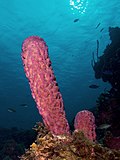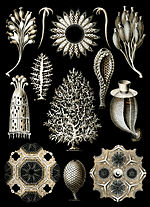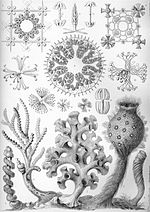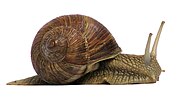up spicule in Wiktionary, the free dictionary. Spicules are any of various small needle-like anatomical structures occurring in organisms Spicule may...
770 bytes (130 words) - 15:21, 28 May 2018
Spicules are structural elements found in most sponges. The meshing of many spicules serves as the sponge's skeleton and thus it provides structural support...
71 KB (7,846 words) - 15:12, 2 November 2024
In solar physics, a spicule, also known as a fibril or mottle, is a dynamic jet of plasma in the Sun's chromosphere about 300 km in diameter. They move...
4 KB (480 words) - 11:23, 5 January 2024
nematodes, spicules, also known as copulatory spicules, are needle-like mating structures found only in males. Male nematodes may have one or two spicules which...
2 KB (143 words) - 19:43, 27 October 2022
Spicules are tiny glass flakes which are formed during the manufacture of glass vials. A glass tube is extruded at a constant rate and a jet of water applied...
816 bytes (130 words) - 03:34, 5 January 2024
Monorhaphis (redirect from Giant basal spicule)
species Monorhaphis chuni, a sponge known for creating a single giant basal spicule (G.B.S.) to anchor the sponge in the sediments. The species was described...
4 KB (382 words) - 07:39, 19 April 2024
species have silica spicules, whereas some species have calcium carbonate exoskeletons. Calcareous sponges have calcium carbonate spicules and, in some species...
132 KB (13,366 words) - 21:15, 29 October 2024
are characterized by spicules made of calcium carbonate, in the form of high-magnesium calcite or aragonite. While the spicules in most species are triradiate...
10 KB (918 words) - 22:15, 9 April 2024
are sponges with a skeleton made of four- and/or six-pointed siliceous spicules, often referred to as glass sponges. They are usually classified along...
20 KB (2,304 words) - 15:07, 8 October 2024
their skeletons out of silica, which forms a unique lattice structure of spicules. The sponges are usually between 10 cm (3.9 in) and 30 cm (12 in) tall...
16 KB (1,768 words) - 04:05, 19 September 2024
osteoid, which increases the size of the spicule. As the spicules continue to grow, they fuse with adjacent spicules and this results in the formation of...
9 KB (965 words) - 12:13, 27 September 2024
made of diffuse meshworks of calcite/silica structural elements called spicules, and echinoderms have a dermal calcite endoskeleton known as ossicles....
5 KB (590 words) - 10:58, 8 July 2024
This is a list of small shelly fossils of prehistoric marine animals, ordered by their type. Namacalathus Yochelsoniella Elements of a scleritome, resembling...
2 KB (329 words) - 03:29, 14 March 2022
part of the body wall is a mantle (or pallium) which secretes calcareous spicules, plates or shells. It overlaps the body with enough spare room to form...
98 KB (9,823 words) - 07:55, 4 November 2024
morphologically indistinguishable from Enterobius vermicularis except the spicule size. Throughout this article, the word "pinworm" refers to Enterobius...
25 KB (2,054 words) - 21:27, 1 November 2024
Osteoblast Osteoblasts (purple) rimming a bony spicule (pink - on diagonal of image). In this routinely fixed and decalcified (bone mineral removed) tissue...
34 KB (3,988 words) - 13:53, 18 October 2024
Suberites dandelenae (section Spicules)
they differ at the spicule level. The following spicules are present in this species: Three distinct size classes of tylostyles (spicule with a point at...
3 KB (303 words) - 01:08, 16 December 2023
ossicles in echinoderms), hydrostatically supported body cavities (most), and spicules (sponges). Cartilage is a rigid connective tissue that is found in the...
31 KB (3,620 words) - 08:30, 5 November 2024
Tetilla capillosa (section Spicules)
(2.4 in) wide. The surface is completely covered in outward projecting spicules which may be up to 4 mm (0.16 in) long. It has a single large oscule (4–6 mm...
3 KB (321 words) - 08:47, 31 October 2024
Their "skeletons" are made of spicules consisting of fibers of the protein spongin, the mineral silica, or both. Where spicules of silica are present, they...
24 KB (2,477 words) - 08:46, 31 October 2024
altitude, but forms a kind of nimbus around chromospheric features such as spicules and filaments, and is in constant, chaotic motion. The transition region...
165 KB (18,120 words) - 05:41, 2 November 2024
Tetilla casula (section Spicules)
long overlapping spicules arranged in parallel bundles. They radiate from a common center in continuation with the lowest spicules of the head, extending...
4 KB (529 words) - 20:32, 30 March 2024
shell small shelly fauna scaly-foot snail shell estuary shells Sponge spicule Test Endoskeletons (bones) Vertebrate skeleton Bone mineral Ossification...
41 KB (4,382 words) - 05:27, 24 October 2024
silica in the form of chert or siliceous skeletal fragments (such as sponge spicules, diatoms, or radiolarians). Fossils are also common in limestone. Limestone...
72 KB (8,485 words) - 15:26, 13 August 2024
atmosphere, just above the photosphere, is the thin chromosphere region, where spicules appear and stellar flares begin. Above this is the transition region, where...
147 KB (16,412 words) - 12:11, 7 September 2024
Cornwall, and in Russia, Germany and elsewhere. Sponges are known from spicules and anchor ropes, and include various forms such as the Calcispongea Cotyliscus...
115 KB (12,080 words) - 11:18, 31 October 2024
colonial tunicate Catellocaula, and various Jurassic-aged and Tertiary-aged spicules tentatively attributed to ascidians.[citation needed]. Fossils of Echinodermata...
35 KB (3,201 words) - 00:11, 28 October 2024
Supergranulation Granule Faculae Sunspot Ellerman bomb Chromosphere Plage Spicule Moreton wave Corona Transition region Coronal hole Coronal loop Coronal...
63 KB (6,605 words) - 10:19, 19 October 2024
commonly to the hardened parts of arthropod exoskeletons and the internal spicules of invertebrates such as certain sponges and soft corals. In paleontology...
8 KB (837 words) - 03:43, 22 July 2024
This may be calcified, forming structures such as shells, bones, and spicules. In contrast, the cells of other multicellular organisms (primarily algae...
128 KB (11,400 words) - 19:32, 4 November 2024






















